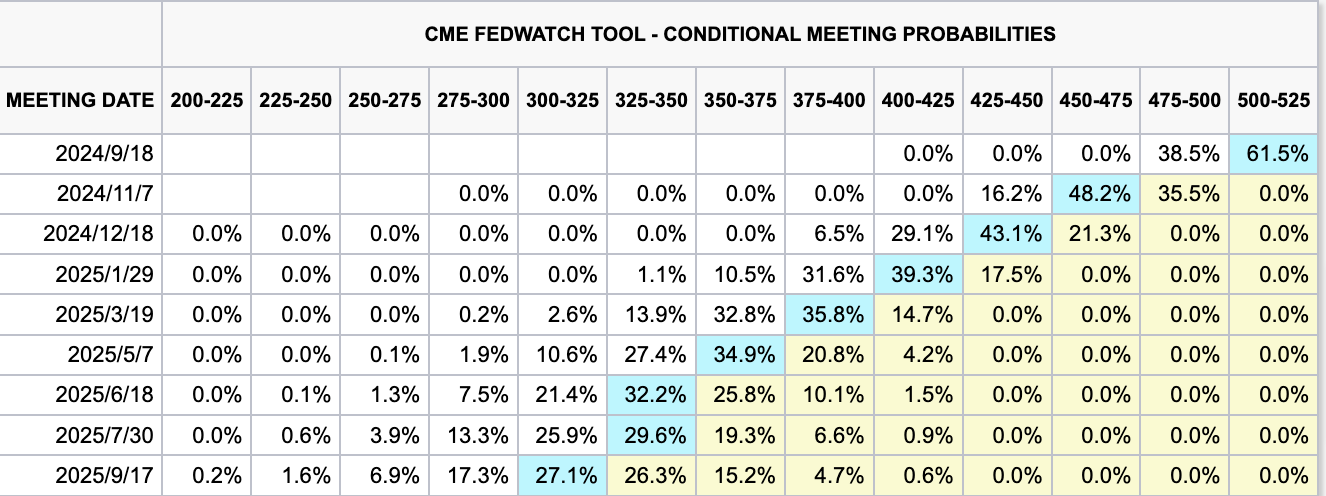U.S. Federal Reserve Chairman Jerome Powell stated at the Jackson Hole annual meeting last Friday that the time is ripe for a rate cut. "The time has come to adjust policy." "The timing and pace of the rate cut depend on the next data, Changing outlook and balance of risks," his clearest signal yet for a rate cut.
Could the Fed drop 2 yards at a time in September?
Bloomberg reported that Ball’s speech caused traders to start betting heavily on the extent of the first interest rate cut and the path of future easing. Data from the CME Group’s Fed Watch tool showed that traders believe the Federal Reserve will cut interest rates by 100 basis points in 2024. And it has increased its bets on a 50 basis point interest rate cut in September.
Interest rate traders believe that the probability of a 2-yard drop in September has increased to 38.5%, and the chance of a normal 1-yard drop is still 61.5%. With only three meetings left this year, traders speculate that the Fed may significantly cut interest rates by 50 basis points at one meeting.
John Velis, foreign exchange and macro strategy analyst at Bank of New York Mellon, said that Ball's remarks highlight that the U.S. monthly non-farm payrolls report released on September 6 is key. "The recent employment data has been worse than expected. If the next set of data is also If so, then 50 basis points may occur ".
Bloomberg analyst Cameron Crise noted that this all puts the focus squarely on the next jobs data in a few weeks, and beyond that, next month's Federal Open Market Committee (FOMC) announcement.
Extended reading: Wells Fargo: Cutting interest rates will trigger the biggest rally in U.S. stocks in 30 years, and the Fed should cut it by two rates in September

U.S. interest rates are about to be cut, and the market is turning to the "dollar carry trade"
It is also worth noting that the interest rate cut signal released by Powell "gave a green light" to investors' risk appetite, which caused U.S. Treasury yields and the U.S. dollar to fall last Friday, and U.S. stocks rose. Wall Street pointed out that the U.S. dollar, which is expected to weaken after interest rate cuts, is replacing the yen as the currency of choice for a new wave of carry trades.
The point is that regardless of the trajectory of interest rate cuts, a shift in interest rates is seen as negative for the US dollar , making the US dollar a potentially attractive currency in carry trades. However, these carry trades are highly dependent on "low volatility", especially financing. Currency volatility, if war in the Middle East escalates, will disrupt traders' game plans as demand for safe-haven assets such as U.S. Treasuries and the U.S. dollar will be boosted.
Citigroup said last week that hedge fund arbitrage trading strategies were reviving, but this time it was choosing dollars instead of yen to finance the trades.
We have seen positioning sentiment against the US dollar start to become more bearish. There is speculation that the environment of interest rate cuts has stimulated risk appetite.
The dollar is currently at its lowest level since March, and hedge funds have been using the greenback to buy emerging market currencies, including the Brazilian real and the Turkish lira, since August 5.
Still, Citi expects global carry trades to only perform well for a short time, as turmoil over the U.S. presidential election could cause dollar volatility to surge again.
Extended reading: When the market crashes, “where does the money go?” Expert: Recession prompts surge in U.S. bonds, appreciation of yen disrupts arbitrage
Wall Street expects PCE data to be positive, supporting the Fed to start cutting interest rates in September
Before the August non-farm payrolls data are released in September, a series of key data will be released this week. The market focus is on the July PCE price index (core PCE data excluding food and energy items) released on August 30. The Fed's preferred inflation indicator), economists predict that the PCE will send a positive signal, supporting expectations that the Federal Reserve will start cutting interest rates in September.
According to the Industrial and Commercial Times report , Wall Street investment banks including Citigroup predict that PCE will increase by 0.2% monthly in July, slightly higher than the monthly increase of 0.1% in June, and the annual growth rate will remain at 2.5%. Core PCE is expected to increase by 0.2% monthly, with the annual growth rate rising from 2.6% in June to 2.7%.
Nationwide Chief Economist Kathy Bostjancic said that the 0.2% monthly increase in core PCE represents a drop in the core CPI 3-month annual rate from 2.3% to 2.1%, approaching the Federal Reserve's 2% target.
Morgan Stanley economist Sam Coffin said that the continued cooling of the core PCE will further support the Federal Reserve to start a rate cut cycle, but he believes that it will only cut interest rates by 1 point in September because economic data is not enough to support a 2-point rate cut. At the same time, he also said that the economic data next this year may be relatively weak, and maintained the forecast of cutting interest rates for the first time in September and cutting interest rates at every meeting until mid-2025.




